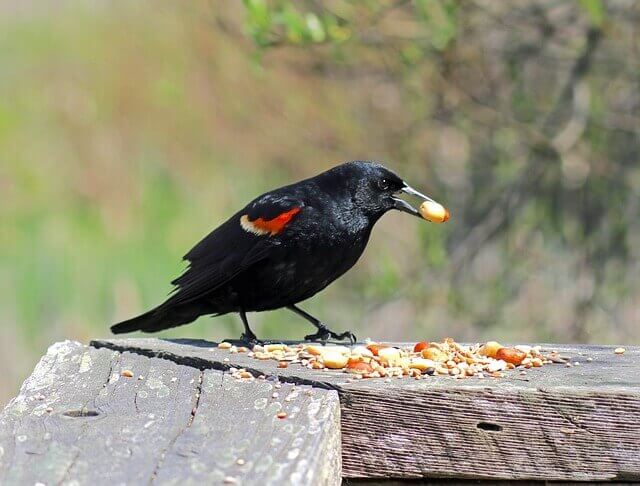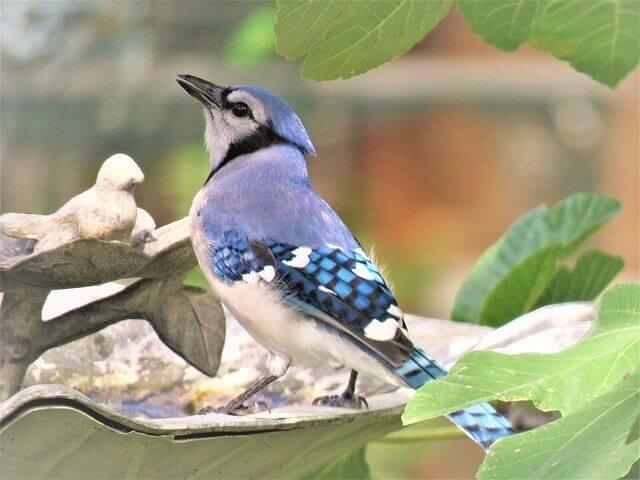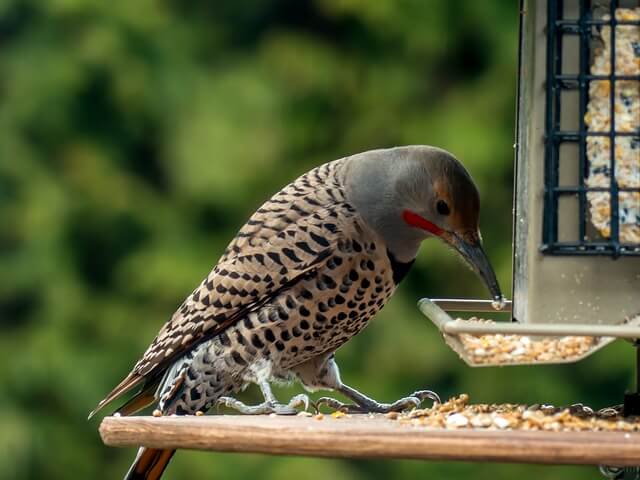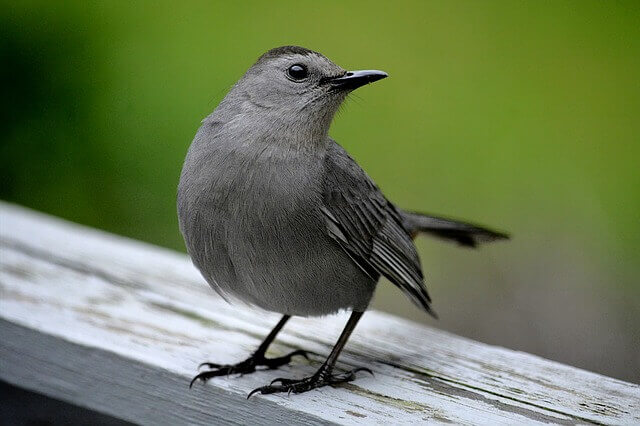Explore Illinois’ diverse birding habitats! From prairies to lakeshores, Illinois offers a rich variety of bird species waiting to be discovered. In this guide, we’ll highlight the 60 most common birds you’re likely to spot across the Prairie State, catering to both seasoned birders and newcomers alike.
Table of Contents
- 1 Most Common Birds in Illinois
- 1.1 Northern Cardinal
- 1.2 American Robin
- 1.3 American Goldfinch
- 1.4 Red-winged Blackbird
- 1.5 Mourning Dove
- 1.6 Downy Woodpecker
- 1.7 European Starling
- 1.8 House Sparrow
- 1.9 Blue Jay
- 1.10 Black-capped Chickadee
- 1.11 American Crow
- 1.12 Song Sparrow
- 1.13 Red-bellied Woodpecker
- 1.14 White-breasted Nuthatch
- 1.15 Common Grackle
- 1.16 House Finch
- 1.17 Dark-eyed Junco
- 1.18 Northern Flicker
- 1.19 Brown-headed Cowbird
- 1.20 Gray Catbird
- 2 Frequently Asked Questions
- 2.1 What are the small blue birds in Illinois?
- 2.2 What are the big black birds in Illinois?
- 2.3 What are small black birds in Illinois?
- 2.4 What is the largest bird in Illinois?
- 2.5 What is the smallest bird in Illinois?
- 2.6 Are there peacocks in Illinois?
- 2.7 Do we have falcons in Illinois?
- 2.8 Are there golden eagles in Illinois?
- 2.9 Are there blue jays in Illinois?
- 2.10 Are there roadrunners in Illinois?
- 2.11 Does Illinois have magpies?
- 2.12 Are there ospreys in Illinois?
- 2.13 Does Illinois have vultures?
- 2.14 Are ibis in Illinois?
- 2.15 Are there ravens in Illinois?
- 2.16 Are there grouse in Illinois?
- 2.17 Are loons in Illinois?
- 2.18 Are there wrens in Illinois?
- 3 Author
Most Common Birds in Illinois
Northern Cardinal

The Northern Cardinal is a beautiful, yet quite elusive bird among North American songbirds. It is most easily identified, however, by its beautiful red plumage and black face mask. This beautiful bird is regularly found in all three of the following regions of North America: from central Minnesota southward through eastern Colorado, Iowa, and Texas, to central Louisiana.
The average lifespan of this beautiful bird is around nine years. On extremely rare occasions, the bird may be found outside these boundaries, usually in sagebrush thickets or along the edges of large mountains. The typical diet of this bird consists of small seeds and insects, with an emphasis on seeds rather than vegetation.
- Frequency: 49.13% (Statistic: eBird)
- Color: Mostly red with a black mask on the face, and a short pink bill.
- Habitat: woodlands, gardens, parks, backyards, and wetlands.
- Range: USA, Canada, Mexico
- Size: 8.2 – 9.3″ inches
- Weight: 33 – 65 grams
- Diet: Fruits, berries, and insects (grasshoppers, beetles, snails, cicadas)
- Family: Cardinalidae
- Genus: Cardinalis
- Map: Range Map
- Sounds: Calls and Songs
Related:
American Robin
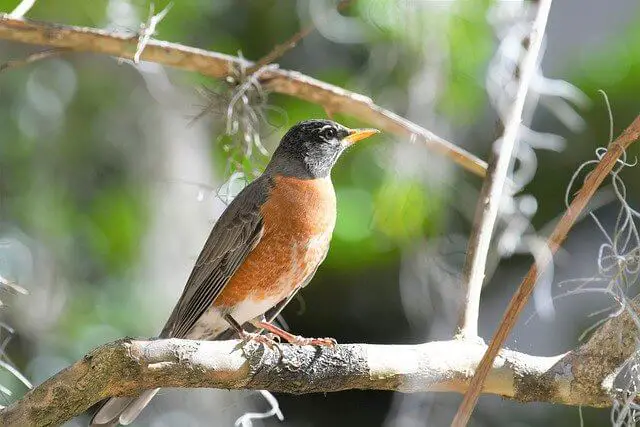
The American robin is a migratory songbird that ranges throughout North America. In the summer months, they can be found in forests, woodlands, and gardens from coast to coast. In the winter, they retreat to southern states and Mexico. Their preferred habitat includes areas with trees and shrubs for nesting and foraging. Robins are also drawn to open spaces where they can find insects and other invertebrates to eat.
Their diet consists mostly of earthworms, insects, and berries. During the breeding season, male robins defend their territory by singing loudly and chasing away intruders. Females construct nests out of twigs and grasses, lined with soft materials like hair or feathers. They lay 3-5 eggs, which hatch after about two weeks.
- Frequency: 48.74%
- Color: Mostly brown on the back with an orange colored breast
- Habitat: Wooded areas, backyards, parks, fields
- Range: USA, Canada, Mexico
- Size: 12 – 16″ inches
- Weight: 72 – 95 grams
- Diet: Fruits, berries and insects (earthworms, beetles, caterpillars)
- Family: Turdidae
- Genus: Turdus
- Map: Range Map
- Sounds: Calls and Songs
Related: Interesting American Robin Fun Facts
American Goldfinch
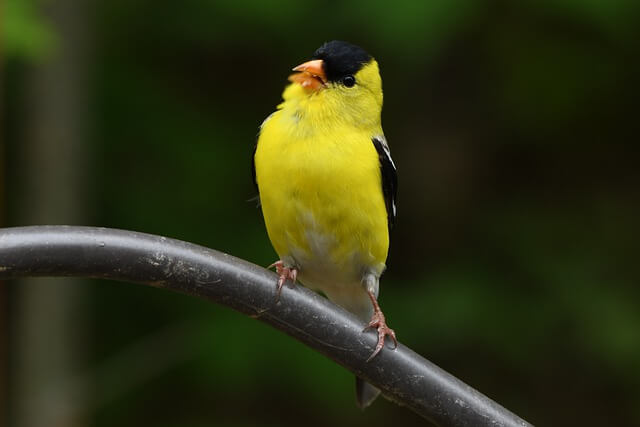
The American Goldfinch is a small songbird found in the United States, and Canada. These cheerful finches are acrobatic, social birds that often travel in flocks. They are also known for their beautiful yellow plumage and black wings. The American goldfinch is also known as the state bird of Iowa, New Jersey, and Washington. Goldfinches are found throughout North America. Their breeding range extends from Alaska and Canada to the Gulf Coast and Mexico.
They can be found in a variety of habitats including forests, fields, gardens and urban areas. American Goldfinches are seed-eaters, and their diet consists primarily of grass seeds. In the winter, they will also eat tree buds and insects. You can attract these lovely birds to your yard by planting sunflowers, thistle or Nyjer seed.
- Frequency: 37.33%
- Color: Face, neck, and underside are yellow, black wings with white bars.
- Habitat: Deciduous forests and thickets, roadside, grasslands, backyards, meadows.
- Range: Canada, USA and Mexico
- Size: 4.3 – 5.5″ inches length
- Weight: 12 -18 grams
- Diet: Grass, dandelions, chickweed, sunflowers and ragweed, thistle, red alder, birch, spruce seeds.
- Family: Carduelinae
- Genus: Spinus
- Map: Range Map
- Sounds: Calls and Songs
Related: American Goldfinch Interesting Facts
Red-winged Blackbird
The red-winged blackbird (Agelaius phoeniceus) is a species of true blackbird in the family Icteridae. The red-winged blackbird is sexually dimorphic, with the male being all black with a distinctive red epaulet on each wing. The female is dark brown with streaked upperparts. Both sexes have yellow eyes. The male sings a loud, flute-like song to attract mates and defend his territory.
The red-winged blackbird has a large range, stretching from Alaska and Canada to Mexico and Central America. This bird can be found in a variety of habitats including wetlands, marshes, fields, and forest edges. The diet of the red-winged blackbird consists mainly of insects, but can also include fruits, seeds, and small vertebrates.
- Frequency: 36.54%
- Color: All black with red patches on shoulder and a yellow wing bar.
- Habitat: Deciduous forests, conifers, roadside, rivers, backyards, parks.
- Range: North America, Central America
- Size: 6.7 – 7.1″ inches length
- Weight: 41.5 – 65 grams
- Diet: Seeds and insects (butterflies, dragonflies, moths, frogs, worms, spider, snails, carrion, flies.)
- Family: Icteridae
- Genus: Agelaius
- Map: Range Map
- Sounds: Calls and Songs
Mourning Dove
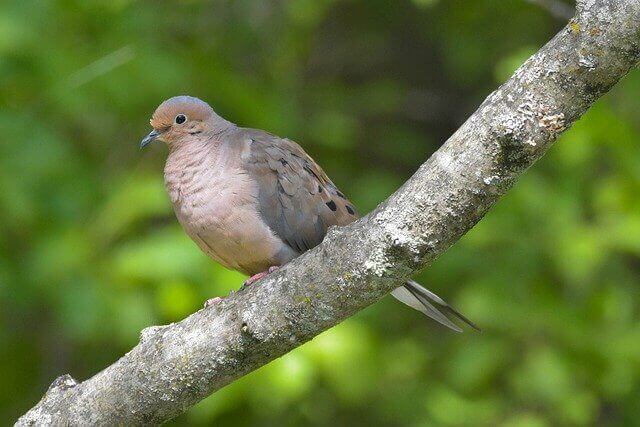
The Mourning Dove is a beautiful bird that can be found in many areas across North America. These birds are relatively small, with sleek, gray plumage. The Mourning Dove gets its name from the characteristic “wailing” sound that it makes, which is often heard during mating season. Mourning Doves are found in a variety of habitats, including woodlands, grasslands, and deserts. They typically build their nests in trees or shrubs, but will also use man-made structures such as fences and buildings.
These birds are generally not migratory, but may move to different areas if food sources become scarce. The diet of the Mourning Dove consists mainly of seeds and fruits. However, they will also eat insects on occasion. These birds usually forage on the ground, using their long beaks to pick up food items.
- Frequency: 34.46%
- Color: Light gray-brown and lighter and pinkish below. The wings have black spots.
- Habitat: Open habitats, urban areas, farms, prairie, grassland, wooded area
- Range: USA, Canada, Mexico, Central America, Greater Antilles
- Size: 12″ inches length
- Weight: 112 – 170 grams
- Diet: Rapeseed, corn, millet, safflower, sunflower seeds, pokeberry, sesame, and wheat.
- Family: Columbidae
- Genus: Zenaida
- Map: Range Map
- Sounds: Calls and Songs
Related:
- Best Bird Feeder For Doves (Reviewed & Tested for 2022)
- Facts About Mourning Doves – 10 Things You Need To Know!
Downy Woodpecker
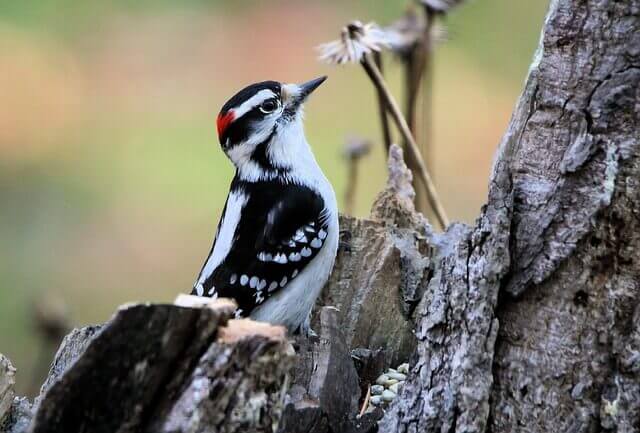
The Downy Woodpecker is a North American woodpecker that ranges from Alaska and Canada to Mexico. It is the smallest woodpecker in North America, measuring just 7-9 inches in length with a wingspan of 13-15 inches. The Downy Woodpecker is black and white with a black cap, white face, and black back. The male has a red patch on the back of his head, while the female does not.
The Downy Woodpecker’s diet consists mostly of insects, but they will also eat berries and nuts. They typically nest in tree cavities or nest boxes. The Downy Woodpecker is a common bird that can be found in forests, parks, and backyards across North America.
- Frequency: 33.40%
- Color: Black with a white throat, belly, and back. White spots on wings
- Habitat: Deciduous forests and thickets, roadside, grasslands, backyards, parks
- Range: Canada, USA, and Mexico
- Size: 5.5 – 7.1″ inches in length
- Weight: 20 – 33 grams
- Diet: Mostly insects and beetles and ants, also gall wasps, caterpillars
- Family: Picadae
- Genus: Dryobates
- Map: Range Map
- Sounds: Calls and Songs
Related: How to Attract Downy Woodpeckers to Your Yard? (Easy!)
European Starling
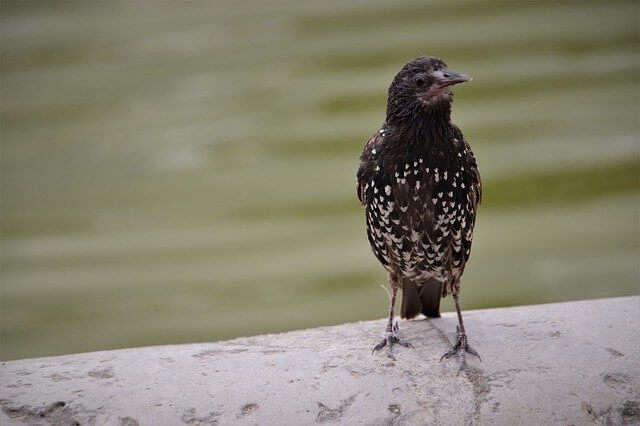
The European Starling (Sturnus vulgaris) is a small passerine bird in the family Sturnidae. The adult male has black plumage with metallic green and purple iridescence, while the female is duller with buffish-brown plumage. Both sexes have yellow eyes and bill. It is about 20 cm in length and 32 g in weight. The European Starling has a large range, occurring across most of Europe, Asia, and parts of Africa.
Its preferred habitat is open country with some trees or scrub for nesting. It feeds on a variety of invertebrates and fruit. The European Starling is a highly adaptable bird, able to live in a wide range of habitats and to make use of a variety of food sources.
- Frequency: 33.24%
- Color: Black with glossy iridescence plumage.
- Habitat: Forests, woodlands, backyards, edges, yards, and parks.
- Range: North America, Europe, Africa, India, Middle East, China.
- Size: 7 – 9″ inches long
- Weight: 60 – 100 grams
- Diet: Insects (ants, beetles, invertebrates), fruits, seeds, berries
- Family: Sturnidae
- Genus: Sturnus
- Map: Range Map
- Sounds: Calls and Songs
Related: How To Attract European Starlings To Your Yard Fast?
House Sparrow
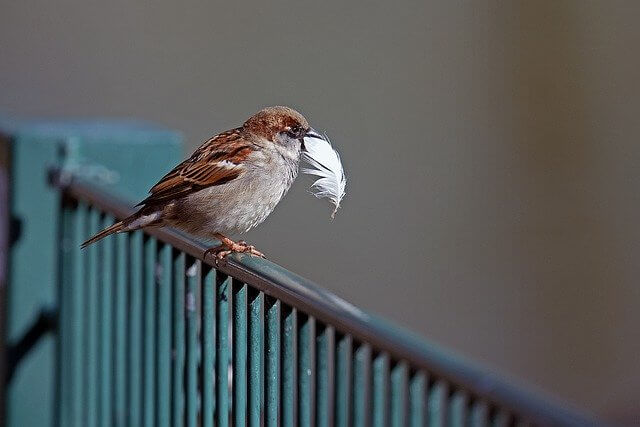
The house sparrow is a small, brown and gray bird with a short tail and stout bill. The adult male has a black throat and upper breast. The female is similar in appearance but has a brown throat and breast. These birds are found in Europe, Asia, Africa and the Americas. The house sparrow prefers open habitats such as farmland, parks and urban areas.
They nest in cavities in trees, buildings or cliffs. The diet of the house sparrow consists of seeds, insects and spiders. The house sparrow is an important bird to agriculture as it helps control insect populations. However, these birds can also be a nuisance as they will eat grain from crops and gather in large numbers around livestock.
- Frequency: 32.79%
- Color: Gray head marking, a reddish-brown back, and gray underparts.
- Habitat: Urban centers, suburban areas, backyards, edges, yards, and parks.
- Range: North America, Central America, South America, Africa, Australia, New Zealand.
- Size: 5.5 – 7.1″ inches in length
- Weight: 25 – 39 grams
- Diet: Insects, beetles, caterpillars, aphids,, grasshoppers, crustaceans, earthworms, vertebrates.
- Family: Passeridea
- Genus: Passer
- Map: Range Map
- Sounds: Calls and Songs
Related: How to Attract Sparrows to your Backyard
Blue Jay
The Blue Jay is a medium-sized songbird with a strikingly blue plumage. The Blue Jay has a large distribution range, extending from central Canada to the Gulf of Mexico. It is a common bird in many habitats including woods, gardens and parks. The Blue Jay is most active during the day and can often be seen perching in trees or flying in search of food.
The diet of the Blue Jay includes a wide variety of items such as insects, nuts and berries. The bird is an opportunistic feeder and will take advantage of whatever food source is available. In winter, the Blue Jay may cache food items for later use.
- Frequency: 32.18%
- Color: Blue crest on the head, wings, back, and tail, and has a white face and belly.
- Habitat: Deciduous and mixed forests, mixed woodlands, backyards, parks.
- Range: Southern Canada, Eastern and Central United States, Florida and Texas.
- Size: 8 – 12″ inches
- Weight: 70 – 100 grams
- Diet: Nuts, seeds, caterpillars, grasshoppers, and beetles.
- Family: Corvidae
- Genus: Cyanocitta
- Map: Range Map
- Sounds: Calls and Songs
Related:
- What Attracts Blue Jays to your Yard?(Expert Tips)
- 15 Best Bird Feeders For Blue Jays (Tried & Tested 2022)
- What Does A Blue Jay Eat? (10 Favorite Foods Revealed!)
Black-capped Chickadee

The black-capped chickadee, is an extremely common, small, North American songbird that lives primarily in mixed and deciduous woods in states like Illinois, Iowa, Missouri, Arkansas, Ohio, and Massachusetts in the United States. It’s the state bird of Massachusetts, and the national bird of New Brunswick in Canada.
They consume, berries, blueberries, black currants, wheat, corn, safflower, peanuts, almonds, grapes. Some species even consume flowers, and seeds, as well as other insects, but these birds are omnivores and will eat nearly all types of plant material that is available to them.
- Frequency: 31.94%
- Color: Black-cap, white on face, white/reddish-brown flanks
- Habitat: Deciduous and mixed forests, backyards, parks
- Range: USA and Canada
- Size: 11.5 -16 cm length
- Weight: 8 – 15 grams
- Diet: Insects, seeds, berries
- Family: Paridae
- Genus: Poecile
- Map: Range Map
- Sounds: Calls and Songs
Related: How Do I Attract Chickadees To My Yard?
American Crow
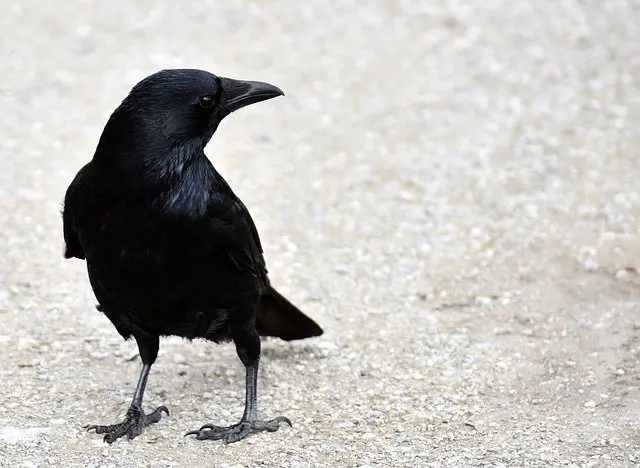
The American Crow is a bird of the Corvidae family and is native to North America. It ranges from Alaska and Canada to the Gulf of Mexico and Central America. The American Crow is also found in the Bahamas, Cuba, and some parts of the Caribbean. The habitat of the American Crow is mainly in open areas such as fields, meadows, pastures, golf courses, parks, and cemeteries.
They are also found in woodlands, forests, and urban areas. The diet of the American Crow consists of insects, earthworms, small mammals, reptiles, amphibians, fruits, nuts, seeds, scraps from human activities such as picnics or garbage dumps.
- Frequency: 29.11%
- Color: Black
- Habitat: Open country, farms, parks, woodlands, towns, cities.
- Range: Canada, USA, Mexico
- Size: 16 – 21″ inches
- Weight: 315 -620 grams
- Diet: Invertebrates, carrion, seeds, eggs fish, grains, mice, frogs, and other small animals.
- Family: Corvidae
- Genus: Corvis
- Map: Range Map
- Sounds: Calls and Songs
Related: How To Attract Crows To Your Backyard: Expert Tips!
Song Sparrow
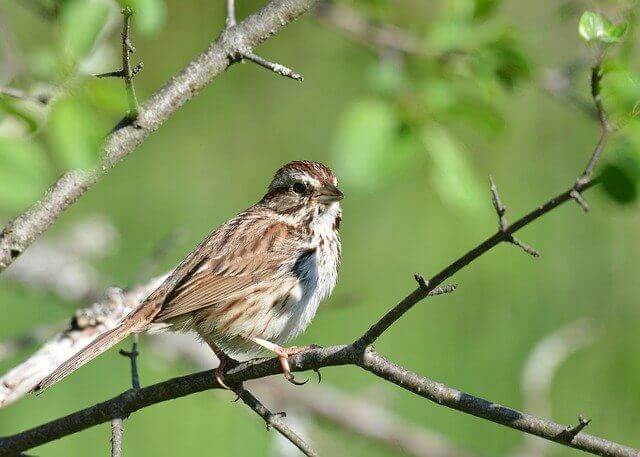
The Song Sparrow (Melospiza melodia) is a medium-sized sparrow. The adult has streaked brown upperparts with a gray breast and white belly. It has a long, dark brown tail with white outer feathers. The face is gray with a brown streak behind the eye. It has a rusty cap and a whitish throat. This sparrow can be found in open woodlands, fields and gardens throughout North America.
The diet of the Song Sparrow consists mainly of insects and seeds. The Song Sparrow typically nests in trees, bushes or on the ground near water. It builds a cup-shaped nest out of grass, twigs, leaves and other plant material. The female lays 3-5 eggs, which are incubated for 11-14 days.
- Frequency: 27.53%
- Color: Gray head, white cheek, a black bib, rufous neck
- Habitat: Urban centers, farms, backyards, edges, yards, and parks
- Range: Europe, Mediterranean, Asia, Australasia, Africa, and the Americas
- Size: 5.5 – 7.0″ inches
- Weight: 25 – 40 grams
- Diet: Grains, seeds, and insects
- Family: Passeridae
- Genus: Passer
- Map: Range Map
- Sounds: Calls and Songs
Related: How to Attract Sparrows to your Backyard
Red-bellied Woodpecker
The red-bellied woodpecker, is a common medium-sized woodpecker of the family Picidae, of which it is one of 24 species in the genus Melanerpes. It breeds mostly in the southern parts of the United States, ranging from central Texas to northern Michigan and as far east as Ontario, Canada.
This bird likes to eat a variety of foods and is a lover of insects, especially cockroaches, moths, and beetles. They also are drawn to garbage; they will follow any trail that may lead them there. You can find the red-bellied woodpeckers in all areas of the north and mid-western United States and also in Central America, especially in Mexico.
- Frequency: 27.53%
- Color: Gray on body and face and underparts. Black and white pattern on wings, back, and tail.
- Habitat: Forests, backyards
- Range: Southern Canada, Eastern United States, Florida.
- Size: 9 – 10.6″ inches long
- Weight: 56 -91 grams
- Diet: Insects, tree frogs, eggs of small birds, oozing sap, and small fish.
- Family: Picidae
- Genus: Melanerpes
- Map: Range Map
- Sounds: Calls and Songs
Related: How to Attract Red-bellied Woodpeckers to your Yard?
White-breasted Nuthatch

The White-breasted Nuthatch is a small songbird that is found in North America. The bird has a black cap and a white face with a black stripe running through its eye. The body of the bird is grayish-brown with a white breast. The nuthatch gets its name from its habit of wedging nuts into cracks in tree bark and then using its bill to crack them open.
The White-breasted Nuthatch is found in deciduous and mixed forests throughout North America. The bird will also use human-made structures, such as houses and sheds, for nesting sites. The nuthatch is a non-migratory bird, meaning it will stay in its range year-round. The diet of the White-breasted Nuthatch consists mainly of insects and seeds.
- Frequency: 23.09%
- Color: Has a white face, flanks, and chest. It has a black cap on its head a bluish-gray upper and a brown belly.
- Habitat: Deciduous forests, conifers, roadside, rivers, backyards, parks.
- Range: Southern Canada, USA
- Size: 5.9″ inches
- Weight: 20 grams
- Diet: Acorn nuts, hickory nuts, ants, caterpillars, scale insects, pine weevils.
- Family: Sittidae
- Genus: Sitta
- Map: Range Map
- Sounds: Calls and Songs
Related: How to Attract Nuthatches to your Backyard
Common Grackle
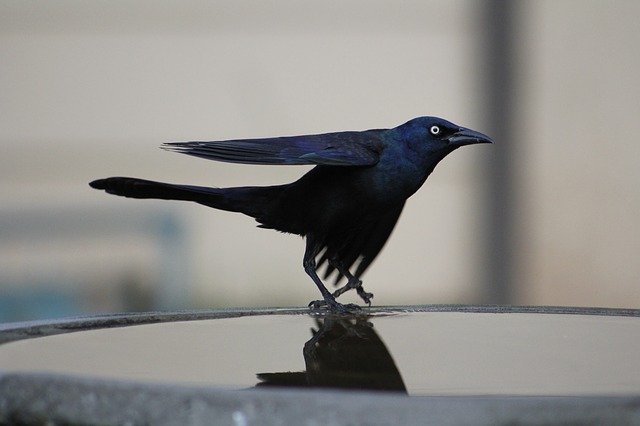
The Common Grackle is a species of true blackbird that ranges from southeastern Canada to northern Nicaragua. They are found in a variety of habitats including open woods, fields, and marshes. Diet consists mostly of insects, but they will also eat seeds, grains, and fruits. Males are easily distinguished from females by their iridescent blue-black plumage.
Females are duller in color with brownish hues on their upperparts. Both sexes have long tails that they often cock at an angle. Common Grackles are aggressive birds that will often chase away other smaller birds from feeding areas.
- Frequency: 22.55%
- Color: Black overall with a blue, and purple iridescence. Its body plumage is a shimmering copper color.
- Habitat: Woodlands, marshes, meadows, parks, backyards, and fields
- Range: East of the Canadian Rockies, Canada and the United States
- Size: 11 – 13″ inches length
- Weight: 75 – 143 grams
- Diet: minnows, eggs, berries, seeds, grain, insects, frogs, mice
- Family: Icteridae
- Genus: Quiscalus
- Map: Range Map
- Sounds: Calls and Songs
House Finch
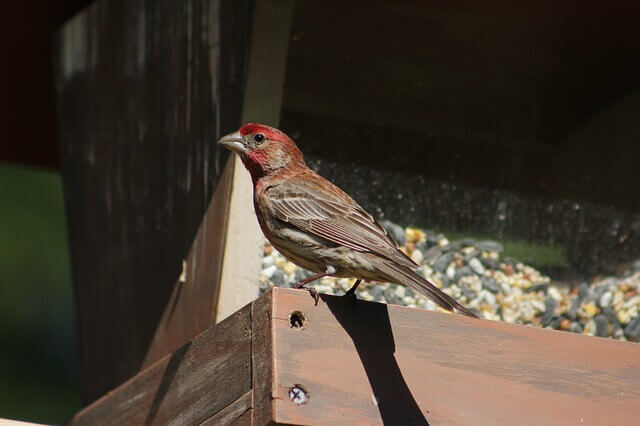
The House Finch is a bird that is found in North America. The range of the house finch extends from southern Canada to northern Mexico. The habitat of the house finch is typically in open areas, such as fields and woods edges.
The house finch is a small bird with a brown back and a reddish breast. The male house finch has a red head, while the female has a brown head. House finches are often seen at bird feeders eating seed. They will also eat insects, such as caterpillars.
- Frequency: 20.50%
- Color: Reddish face and upper breast, brown streaks on back, belly, and tail.
- Habitat: Urban and suburban areas, backyards, edges, yards, and parks
- Range: Canada, USA, Mexico
- Size: 5 – 6″ inches
- Weight: 16 – 27 grams
- Diet: Aphids, grains, seeds, berries, nettle, dandelion, sunflower
- Family: Fringillidae
- Genus: Haemorhous
- Map: Range Map
- Sounds: Calls and Songs
Related: How to Attract House Finch to Your Yard?
Dark-eyed Junco

The dark-eyed junco is a small sparrow that can be found throughout North America. The dark-eyed junco is easily identified by its gray feathers and white belly. These birds are pretty small, measuring only about six inches in length. They are commonly seen in wooded areas, but they can also be found in open fields and even urban areas.
The diet of the dark-eyed junco consists of insects, seeds, and berries. The dark-eyed junco is a very adaptable bird and can live in a variety of habitats. However, they prefer to nest in coniferous forests where there are plenty of trees for them to build their nests. These birds are not migratory, so they will stay in their chosen habitat year-round.
- Frequency: 20.50%
- Color: Gray head, neck, breast, gray/brown backs and wings, white underside
- Habitat: Wooded areas, forest edges, roadsides, gardens, parks.
- Range: USA and Canada
- Size: 5.1 – 6.9″ inches
- Weight: 18 – 30 grams
- Diet: Seeds, insects, and arthropods
- Family: Passeriformes
- Genus: Junco
- Map: Range Map
- Sounds: Calls and Songs
Related: Fun Facts About Dark-eyed Juncos
Northern Flicker
The Northern Flicker is a woodpecker belonging to the woodpecker family.. It is a medium-sized bird with a brown back, white underparts, and a black bib. The wings are barred with black and white, and the tail is black with a white rump. The male has a red patch on the nape of the neck, while the female has a yellow nape.
The Northern Flicker is found across North America from Alaska to Newfoundland, south to Mexico and Costa Rica. It is most commonly found in woods or forests, but can also be found in urban areas such as parks and gardens. The diet of the Northern Flicker consists mainly of insects, but it will also eat berries and seeds
- Frequency: 18.36%
- Color: Light brown with black bars across back, chest, wings, belly
- Habitat: Forests, woodlands, backyards, edges, yards, and parks
- Range: North America, Central America, Cuba, Cayman Islands
- Size: 10 – 14″ inches
- Weight: 85 – 165 grams
- Diet: Insects (ants, beetles, invertebrates), fruits, seeds, berries
- Family: Picadae
- Genus: Colaptes
- Map: Range Map
- Sounds: Calls and Songs
Related: How to Attract Northern Flickers to your Backyard? (Easy)
Brown-headed Cowbird
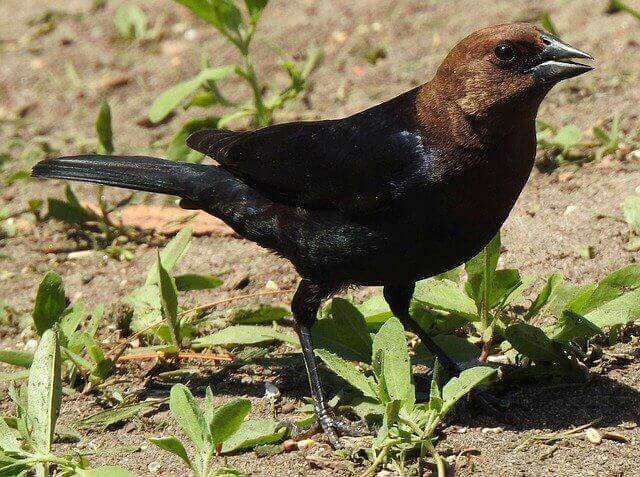
The Brown-headed Cowbird is a small bird with black plumage and chocolate brown head. The male has a black body with iridescent purple and green highlights, while the female is dark brown with pale streaks. Both sexes have short tails and brown eyes. The Brown-headed Cowbird is found in open habitats across North America. In the east, it breeds in deciduous forests, while in the west it is found in both coniferous and deciduous forests, as well as grasslands.
It generally avoids dense habitats such as swamps. The diet of the Brown-headed Cowbird consists primarily of insects, although it will also eat some berries and seeds. It forages on the ground or in low vegetation, often following larger birds such as cows or bisons to catch insects that they stir up.
- Frequency: 16.90%
- Color: Iridescent black plumage and has a brown head
- Habitat: Forest edges, backyards, parks, suburban bird feeders
- Size: 6.3 – 8.7″ inches in length
- Weight: 30 – 60 grams
- Diet: Seeds and insects (grasshoppers, beetles, spiders)
- Family: Icteridae
- Genus: Mater
- Map: Range Map
- Sounds: Calls and Songs
Gray Catbird
The Gray Catbird is a small songbird that ranges in wooded habitats throughout much of the eastern United States and Canada. These birds are easily recognized by their gray plumage and black cap, and they are often seen perching on tree branches or foraging for food on the ground.
The diet of Gray Catbirds consists primarily of insects, but they will also eat fruits and berries. Gray Catbirds are relatively common birds, and their populations appear to be stable. However, these birds are sensitive to habitat loss and fragmentation, so it is important to protect woodland areas where they live.
- Frequency: 14.86%
- Color: Mainly Gray with black on tail and head, white accents on the body
- Habitat: Woodlands, marshes, meadows
- Range: East of the Canadian Rockies, Canada, USA, Mexico, Central America, and the Caribbean
- Size: 8 – 9.5″ inches
- Weight: 23 – 57 grams
- Diet: Fruits, berries, earthworms, beetles, bugs, ants caterpillars, grasshoppers, moths.
- Family: Mimidae
- Genus: Dumatella
- Map: Range Map
- Sounds: Calls and Songs
The backyard birds listed below are all under 15% Frequency
- Barn Swallow – 14.82% Frequency
- Tree Swallow 13.35%
- Common Yellowthroat 13.12%
- House Wren 12.69%
- White-throated Sparrow 12.63%
- Indigo Bunting 11.68%
- Chimney Swift 11.66%
- Rock Pigeon 11.38%
- Cedar Waxwing 10.76%
- Yellow-rumped Warbler 10.62%
- Chipping Sparrow 10.09%
- Hairy Woodpecker 9.86%
- Eastern Bluebird 9.86%
- Eastern Phoebe 9.69%
- Blue-gray Gnatcatcher 9.58%
- Tufted Titmouse 9.53%
- Baltimore Oriole 9.17%
- Field Sparrow 9.04%
- Eastern Wood-Pewee 9.00%
- Carolina Wren 8.68%
- Eastern Towhee 8.13%
- American Tree Sparrow 7.85%
- Eastern Meadowlark 7.75%
- Eastern Kingbird 7.38%
- Warbling Vireo 7.35%
- Yellow Warbler 7.29%
- Ruby-crowned Kinglet 7.09%
- American Coot 6.91%
- Red-eyed Vireo 6.77%
- Swamp Sparrow 6.55%
- Ruby-throated Hummingbird 6.52%
- Northern Rough-winged Swallow 6.40%
- Palm Warbler 6.26%
- White-crowned Sparrow 6.19%
- Brown Thrasher 6.12%
- Belted Kingfisher 6.12%
- Rose-breasted Grosbeak 6.07%
- American Redstart 5.95%
- Great Crested Flycatcher 5.60%
- Red-headed Woodpecker 5.19%
Frequently Asked Questions
What are the small blue birds in Illinois?
There are four small blue birds that can be found in Illinois: the Blue Jay, the Indigo Bunting, the Eastern Bluebird, and the Mountain Bluebird. The Blue Jay is the most common of the four and can be found in wooded areas throughout the state. The Indigo Bunting is next most common, and they can be found in open areas near forests.
What are the big black birds in Illinois?
There are many black birds in Illinois, but the two most common are Common Grackles and Red-winged Blackbirds. Both of these birds are relatively large, with Common Grackles being the larger of the two. They can both be found in a variety of habitats, but they prefer open areas with some trees or shrubs. Common Grackles will also often be found near water, while Red-winged Blackbirds are more likely to be found in marshes or wetlands.
What are small black birds in Illinois?
There are a few small black birds in Illinois, but the most common is the European Starling. These birds are about eight inches long and have a wingspan of about 12 inches. They are black with white spots on their wings and have a yellow beak. They are found in yards, woods and fields and often nest in trees.
What is the largest bird in Illinois?
The Golden Eagle is the largest bird in the state of Illinois. It has a wingspan of up to 8 feet and can weigh up to 15 pounds. The Golden Eagle is a very powerful bird and can reach speeds of up to 200 miles per hour. It is also a very good hunter and can kill animals as large as deer.
What is the smallest bird in Illinois?
The Ruby-throated Hummingbird is the smallest bird in Illinois. Males of this species typically weigh between 2.6 and 3.5 grams, while females usually weigh between 2.2 and 3.3 grams. The average length of this hummingbird is approximately 3 inches. These tiny birds are found in a variety of habitats throughout Illinois, including woodlands, prairies, and gardens. Although they are small, Ruby-throated Hummingbirds are fierce predators that use their long beaks to catch insects in midair.
Are there peacocks in Illinois?
There are no peacocks in the wild in Illinois. The only place you might see a peacock is at a zoo or an animal sanctuary. Peacocks are not native to Illinois, and there is no climate here that would support them.
Do we have falcons in Illinois?
There are three species of falcon that have been documented in Illinois: the Peregrine Falcon, Prairie Falcon, and Gyrfalcon. All three of these species are considered rare, with the Peregrine Falcon being the most common.
Are there golden eagles in Illinois?
According to eBird, golden eagles are very rare in Illinois, with a frequency of occurrence of only 0.0391%. These large birds are not often seen in the state, but there have been a few sightings reported.
Are there blue jays in Illinois?
Blue jays are one of the most commonly seen birds in Illinois. According to eBird, their frequency of occurrence is 32.77%. That means that if you see 10 birds in Illinois, 3 of them are likely to be blue jays.
Are there roadrunners in Illinois?
There are no roadrunners in Illinois. The roadrunner is a bird that is native to North, Central, and South America. It is not found in Illinois because the climate is not conducive to its survival. The roadrunner prefers hot, dry climates, and Illinois has a temperate climate with four distinct seasons. There are many other birds that call Illinois home, but the roadrunner is not one of them.
Does Illinois have magpies?
Magpies are interesting birds that are not commonly seen in Illinois. There is only one species of magpie that has been reported in the state, and that is the Black-billed Magpie. These birds are very rare according to eBird with a frequency of only 0.0002%. Although they are not commonly seen, they are still an occasional visitor to Illinois.
Are there ospreys in Illinois?
There have been occasional sightings of ospreys in Illinois. According to eBird, a website that collects data on bird sightings, the frequency of ospreys in Illinois is only 1.64%. This means that they are very rare visitors to the state. Most of the sightings have been in the spring and summer months.
Does Illinois have vultures?
Turkey Vulture and the Black Vulture are the two species of vultures that are found in Illinois. The Turkey Vulture is the most common, while the Black Vulture is less often seen. Both species feed on carrion, so they can often be found near roadsides or in open fields where there is a lot of activity.
Are ibis in Illinois?
There are three species of ibis that have been recorded in Illinois: the White-faced Ibis, the Glossy Ibis, and the White Ibis. All three species are vagrants, meaning they do not breed in Illinois and are only seen occasionally. The White-faced Ibis is the most likely of the three species to be seen in Illinois. This bird breeds in marshes in the western United States and southern Canada, but it sometimes wanders eastward in search of food.
Are there ravens in Illinois?
According to eBird, Common Ravens are very rare and accidental in Illinois, with a frequency of occurrence of only 0.0002%. However, there have been a few sightings of ravens in the state, so it is possible that there are a few individuals living here.
Are there grouse in Illinois?
Although grouse are not particularly common in Illinois, there have been instances where they have been spotted in the state. According to eBird, a website that tracks bird sightings, grouse are very rare and accidental with a frequency of occurrence of only 0.0002 percent. In other words, out of every 10,000 bird sightings in Illinois, only two will be grouse.
Are loons in Illinois?
Loons are a type of waterbird that is found in many parts of the world, including Illinois. There are four main types of loons: the common loon, the red-throated loon, the Pacific loon, and the yellow-billed loon. All four types of loons are rare in Illinois, with the common loon being the most likely to be seen. The other three types are very rarely seen in the state.
Are there wrens in Illinois?
There are seven species of wrens that have been documented in Illinois, the House Wren, Carolina Wren, Marsh Wren, Winter Wren, Sedge Wren, Bewick’s Wren, and Rock Wren. Of these, the House Wren is the most common, followed by the Carolina Wren. The Rock Wren is the least common.
Related Post:


